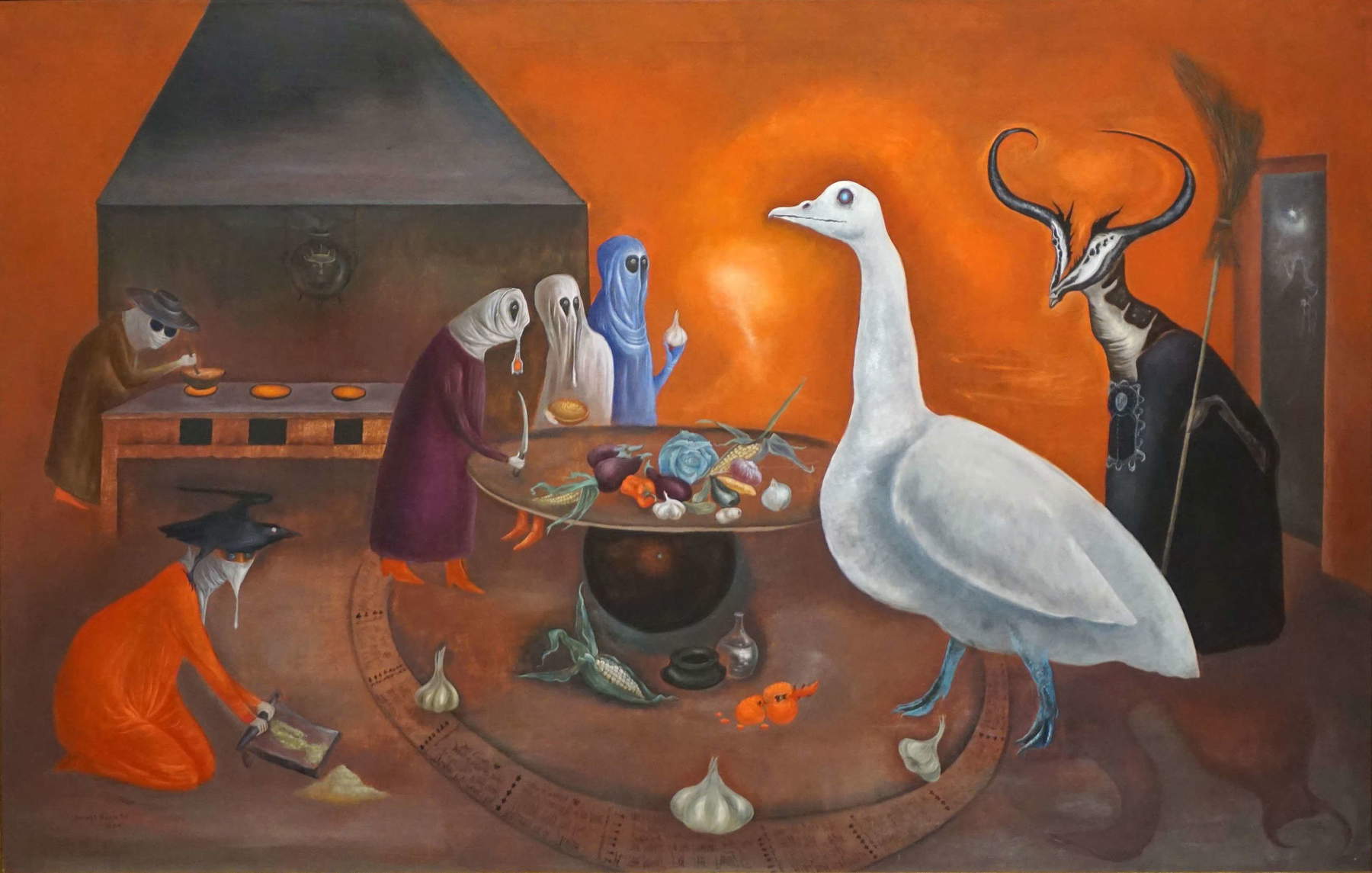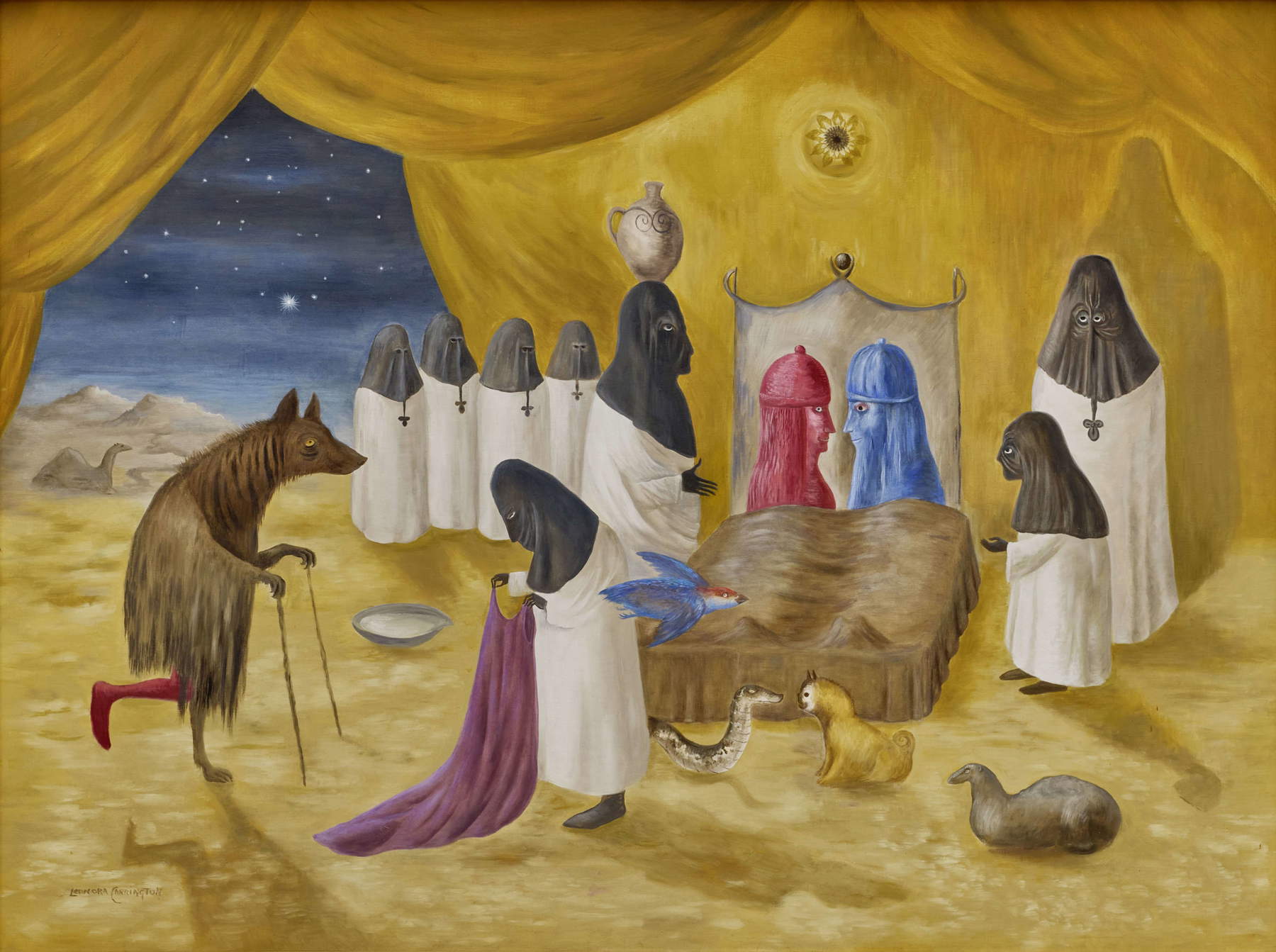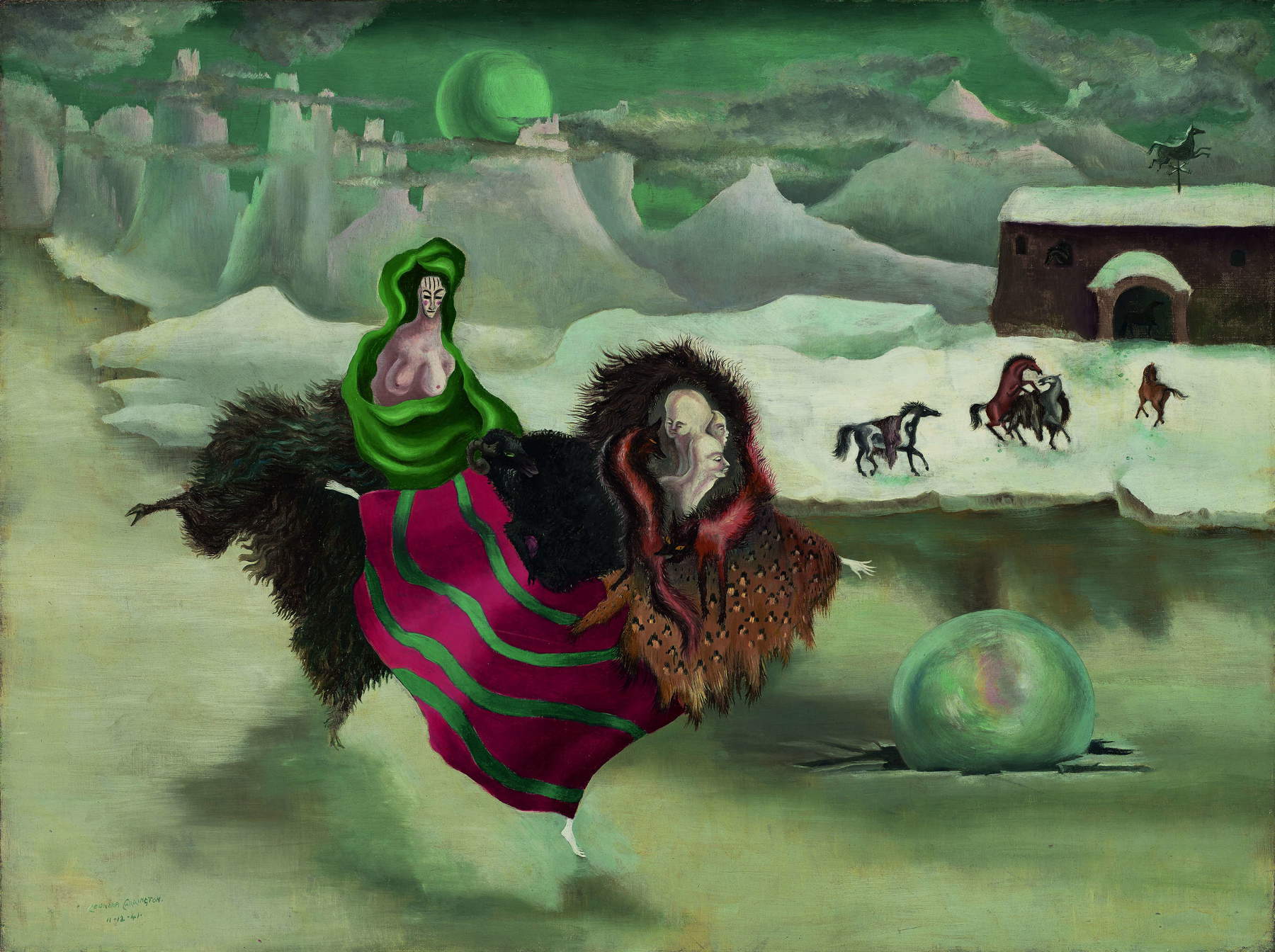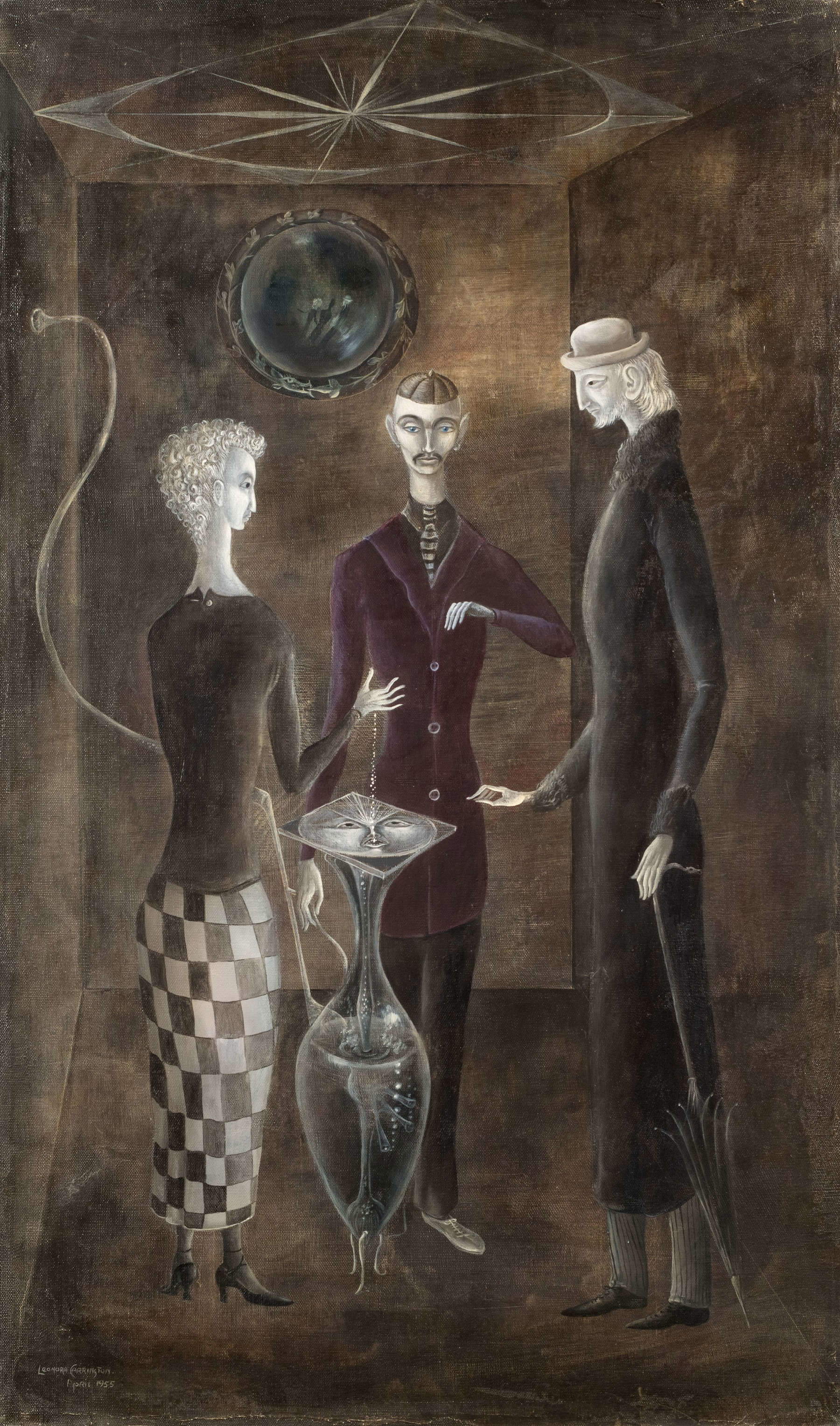From Sept. 20, 2025 to Jan. 11, 2026, the halls of Palazzo Reale in Milan will host the exhibition Leonora Carrington, a retrospective (the first in Italy) featuring more than 60 works that reconstructs the life and career of British surrealist Leonora Carrington (Clayton Green, 1917 - Mexico City Mexico City, 2011), an artist who, starting in her native Lancashire with her Celtic roots, lived in Florence, Paris, southern France, Spain and New York, and finally in Mexico, where she settled permanently and where she has long been celebrated as one of the most important artists, alongside Frida Kahlo and Remedios Varo. The exhibition is promoted by the City of Milan-Cultura, produced by Palazzo Reale, MondoMostre, Civita Mostre e Musei and Electa, and realized thanks to Unipol Group, main partner, and Pirola Pennuto Zei & Associati, premium partner.
The initiative is part of the program of theMilan Cortina 2026 Cultural Olympiad and aims to offer a glimpse of Leonora Carrington’s artistic production and intellectual identity through an articulated itinerary of paintings, drawings, photographs and archival materials that explores the entire span of her creative life, from her origins in Europe to her roots in Mexico, her second homeland, seeking to restore the space she deserves within the history of modern and contemporary art. The project, curated by Tere Arcq and Carlos Martín, is in continuity with the retrospective dedicated to Leonor Fini(here is our review), which, again at the Palazzo Reale in Milan under the curatorship of the two scholars, closes in July after nearly six months of exhibition. Fini and Carrington: both women, linked, albeit in different ways, to the Surrealism movement, revolutionaries and nonconformists.
The exhibition brings together a nucleus of works from major international institutions and private collections, testifying to the global resonance of the figure of Leonora Carrington. Prestigious lenders include the Dallas Museum of Art, the Art Institute of Chicago and the Goddards Charles B. Center in the United States, Banco Nacional de México, FAMM (Femmes Artistes du Musée de Mougins) in France, the Galleria Nazionale d’Arte Moderna e Contemporanea - GNAM in Rome, Frahm & Frahm, as well as numerous private collectors from around the world who have generously contributed to the exhibition project. The “Leonora Carrington” exhibition, after Milan, will be presented in Paris at the Musée du Luxembourg.
Leonora Carrington was a painter, sculptor, writer, playwright and pioneer of feminist and ecological thought. Her work mixes dream and reality, magic and politics, myth and psychology, shaping a complex and multifaceted world that eludes categorization. The exhibition project aims to restore Carrington’s multifaceted richness in the first monographic exhibition ever presented in Italy: transnational and extraterritorial artist, mother, exile, radical intellectual and tireless explorer of consciousness. Her research finds resonances in contemporary issues and has had exceptional posthumous resonance, especially after her inclusion in the 2022 Venice Biennale, which took one of her stories as its title and motto: The Milk of Dreams. This exhibition aims to continue that path of affirmation and recognition, celebrating Leonora Carrington as one of the most influential and revolutionary artists of the 20th century, capable of dialoguing with new generations and stimulating profound reflections on the role of art and knowledge.
The proposed exhibition aims to make her kaleidoscopic world and dense intellectual personality accessible to new audiences as well through a wide selection of works and documents that showcase her multiple and heterogeneous creations.



Several themes are addressed by the exhibition. There is, first of all, the deep connection with Italy, which was a decisive stage in Carrington’s formation; in particular, in the Florence of the early 1930s she consolidated her decision to devote herself to art and absorbed essential pictorial influences, which will always remain in her imagination, such as those of the painters of the 14th and 15th centuries, fundamental throughout her career.
The exhibition then addresses themes ranging from the female body to the human psyche, from folklore to power structures, revealing a personal and universal vision read from the present, an ability on the part of the artist to anticipate issues at the center of cultural debate today. Her fantastical creatures, alchemical symbols, and mythological figures become tools for investigating the human condition, opening up new possibilities for reading the present.
Leonora Carrington was then a woman, cosmopolitan, stateless, survivor of war and psychiatric internment. She survived mental illness and exile. The early years of her life were marked by escape: after managing to study in Italy, despite her father’s opposition, she came into contact with the Surrealists and fled with them from the suffocating control of her father figure and the violence of war and to Europe. He took refuge in Mexico, where he reconstructed his identity and his art. Shortly before the beginning of her stay in Mexico, she had been admitted to a psychiatric hospital in Santander, in early Francoist Spain, where she underwent traumatic treatment in inhumane conditions-an experience she recounted in her extraordinary book Down Below. His work and his life reflect a profound resilience and capacity for transformation: in the face of trauma he was able to convert pain into creativity and denunciation.
Also important are the themes ofecology and feminism. Leonora Carrington was a pioneer of ecofeminism by weaving the defense of nature and women’s rights into her work. Her art and thought highlight the connection between women and the environment, denouncing man’s predatory attitude and promoting female autonomy and respect for life in all its forms through highly personal fertility metaphors. She has also always advocated a “feminism of consciousness,” conscious and inclusive of all genders, in a harmonious worldview inspired by the principles of alchemy.
Leonora Carrington’sfairy-tale imagination also unfolds in her stories as boundless territory, where the fantastic and dreamlike are interwoven with elements of fable and fairy tale. Her stories are populated by talking animals, unexpected metamorphoses and scenarios in which the absurd seemingly coexists with the everyday, as in the universe of her admired Lewis Carroll. Carrington uses the intuitive logic of children’s stories to create universes in which transformation and freedom are possible, defying the norms of reality and traditional morality. Her stories and paintings show hybrid creatures, girls conversing with hyenas, trees chasing youngsters, and queens bathing in goat’s milk. The author transforms fairy tales into spaces of rebellion and critique, where humor, horror and magic mingle to subvert gender roles and social hierarchies. Thus, Carrington’s imagination is not just escape, but an act of creation and resilience.
At the heart of her art then lie forgotten myths and recovered knowledge. Esoteric currents throughout history, mythologies that have fallen into oblivion, and the divinatory arts are subjects that interest Carrington because they are considered an alternative way to access the unconscious and the enigmas of human beings and nature. In Mexico, together with Spanish painter Remedios Varo and Hungarian photographer Kati Horna, she delves into the world of magic, understood by all three as a tool for recovering “forbidden” female powers. Books on magic, alchemy, astrology and tarot occupy a privileged place in his library, as well as providing him with iconographies that he uses over and over again in his work, seeking to restore to these knowledges the place that has been stolen from them throughout history.
Finally, the exhibition will address three themes that are distinctive to Leonora Carrington’s art and, in turn, interrelated: matriarchy, cooking, andalchemy. Carrington explored the concept of matriarchy starting with a domestic space (the kitchen) and one of the forbidden knowledge of the past (alchemy) as spatial, creative and symbolic axes. In her works, the kitchen is transformed into a space of feminine power and ritual, where food preparation becomes a magical and alchemical act. Carrington saw the kitchen as a workshop and altar where women, central and matriarchal figures, perform transformative processes, mixing ingredients and ancestral knowledge, while sharing confidences in a safe space. Her cookbook and paintings fuse cooking with mysticism, highlighting the importance of creativity, spirituality and female autonomy in the domestic and artistic spheres.

The exhibition is divided into five nuclei, some chronological, some thematic, each devoted to a crucial moment in Leonora Carrington’s artistic and existential journey.
The first section is titled Leonora’s Grand Tour. It begins with her education and the Grand Tour that took her from England to France, Switzerland and Italy, a moment evoked in the series Sisters of the Moon (1932-1933), made between the ages of 15 and 16. This wide-ranging series features imaginary women, powerful and endowed with enigmatic knowledge, who generate a kind of alternative cosmogony dominated by the feminine and imaginary creatures or fantastic beasts that coexist with human beings. In these works from his very early youth, one can already sense what would be his deepest interests in life: sisterhood, the affabulatory imagination, the literary component, the invention of mythologies, and some esoteric aspects such as astrology. The second section is La Mariée du vent: Surrealism, from Saint-Martin d’Ardèche to New York. This section takes as its title the nickname she received from her companion during the years of her association with Surrealism, Max Ernst, who dubbed her: “the bride of the wind” in the prologue written for one of Carrington’s short stories. It was in Surrealism that Carrington, as a writer and painter, began to shape a personal world and find her own voice. Prominent in this section are the creations made for the total work of art that was the house she shared with Ernst in Saint-Martin d’Ardèche, southern France. Leonora Carrington then suffered, like most Europeans, the experience of war. But, in addition, she also underwent the experience of mental illness and imprisonment (during her Spanish period in a sanatorium in Santander) as well as the trauma of exile, when she sought the warmth of the other side of the Atlantic, away from the warring world, in New York, along with other Surrealists. Present in the exhibition itinerary are key works from that period of exile, for her with no return, where a mature language was already being forged: Garden Bedroom (1941), Caballos (1941) or La joie de patinage (1941), in dialogue with Ernst’s masterpiece, The Spanish Physician (1940), a great metaphor for the painter’s experience, with a fleeing Carrington as its protagonist.
It continues with the third section, Spesamento: bilocation and fairy-tale imagination. Throughout Leonora’s childhood, and throughout her life, fairy tales and the genre of fantasy and adventure would ignite her imagination. At Crookhey Hall Nursery School, her childhood home, her mother Maureen Moorhead and her nanny Mary Kavanaugh, both of Irish descent, would tell Celtic myths and stories by some of her favorite authors-Lewis Carroll, Hans Christian Andersen, the Brothers Grimm, James Stephens and Jonathan Swift. When Leonora Carrington settled in Mexico and set up home and family in the latter half of the 1940s, the dreamlike and ghostly memories of her upbringing in that Lancashire mansion returned. Her work underwent the experience of bilocation, of being in two places at the same time: her home in the new world, and her childhood memories of a distant Europe that remained alive in her unconscious; her being a mother and her being, again, a helpless child. All this took shape in a series of works in which she found her definitive, mature voice, starting with the masterpiece Las tentaciones de san Antonio (1945), where she dialogues with Italian and Flemish Renaissance painting, but also others where the format of the predella, the use of tempera or the atmosphere of the sacred conversation take her back to her Florentine training, such as The Elements (1946) or Night Nursery Everything (1947). This look backwards, with a calmer aesthetic and undeniable technical mastery, also marks an important milestone in her career, as her first solo exhibition took place in 1948, at the Pierre Matisse Gallery in New York.
The fourth section is entitled The Heroine’s Journey. Carrington’s research is directed at those dark places of knowledge where light and shadow coexist, spaces that are investigated by various alter egos, female, by the artist, by various “heroines.” Joseph Campbell, author of the famous study on narrative structure entitled The Hero’s Journey, believed that when there is a dissolution of the social structure of the unconscious, the individual needs to find something new, and the only possible path is to embark on a heroic journey, a new quest that departs from the canonical religious tradition. This section explores Carrington’s work and biography as a female transcript of that “hero’s journey.” Leonora Carrington spent her life, as her son Gabriel recalls, “always searching for inner maps to help her navigate her visionary life and inner demons,” and her roadmap was a rich and complex cartography of mystical and spiritual traditions drawn from ancient and more contemporary teachings. An outstanding example is The Magus Zoroaster Meeting his Own Image in the Garden (1960), where in Carrington’s clever and unique syncretic ways, he depicts the dual image of the prophet, also known as Zarathustra and founder of the ancient Persian religion, Zoroastrianism, with verses from Percy Shelley’s play Prometheus Unbound. By the early 20th century, Mexico was animated by competing esoteric practices including Spiritualism, Freemasonry, Gnosticism, and Madame Blavatsky’s Theosophy, but particularly attractive to Carrington were the ideas of the Russian-Armenian mystic George I. Gurdjieff toward the evolution of consciousness evident in works such as Under the Compass Rose (1955).
Closing with the section The Alchemical Kitchen: inspired by a term coined by Susan Aberth, this section examines how Carrington incorporated an incursion of magical traditions into his work, not only using arcane symbolism, but also depicting complex notions of the temporal and spatial alterations that occur around this “alchemical kitchen.” The kitchen became a metaphor for hermetic operations, a place traditionally associated with female drudgery and constraint became the setting in which women could reclaim their powers through alchemy, magic, and sorcery. In Mexico, Carrington’s interest in cooking, which began during her idyllic times in Saint-Martin-d’Ardeche, was enriched after the discovery of fascinating new ingredients for food preparation, as well as the variety of herbs and plants found at the Sonora witch market to be used for spells and potions.
A red interior with a stove, typical of the Puebla region, becomes the setting for the painting Grandmother Moorhead’s Aromatic Kitchen (1974), where a group of mysterious characters, including animals and humans, cook tortillas and grind corn around a table within a magic spell circle under the gaze of a huge goose and a witch. Significantly, he used a reference to the place where mole, one of the country’s most famous gastronomic treasures, was devised by humble nuns in a convent mixing the few ingredients they had to please a visiting archbishop. As in many of her works, the setting becomes a site of female re-empowerment in which her interest in esotericism, transformation and imagination are fused with the symbolism of food, shaping a vision in which the act of cooking becomes a magical, ritualistic and deeply creative practice.
The exhibition catalog is published by Electa, with texts by Gabriel Weisz Carrington, professor of Comparative Literature at UNAM, Mexico; Karla Segura Pantoja, professor at the Université de Lyon, France; Susan Aberth, holder of the Edith C. Blum Chair in Art History and Visual Culture and coordinator of the Theology Program at Bard College; Kristoffer Noheden, writer and researcher in the Department of Media Studies at Stockholm University; and Carlos Martín and Tere Arcq, co-curators of the exhibition.
 |
| In Milan, Italy's first exhibition on Leonora Carrington, 60 works at Palazzo Reale |
Warning: the translation into English of the original Italian article was created using automatic tools. We undertake to review all articles, but we do not guarantee the total absence of inaccuracies in the translation due to the program. You can find the original by clicking on the ITA button. If you find any mistake,please contact us.